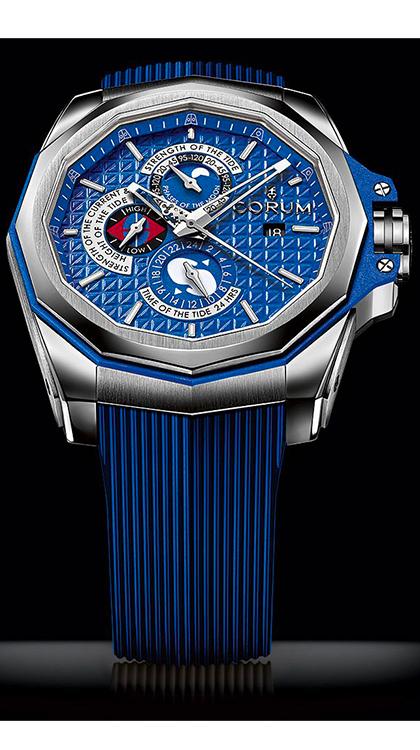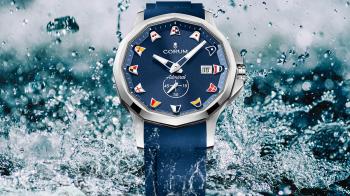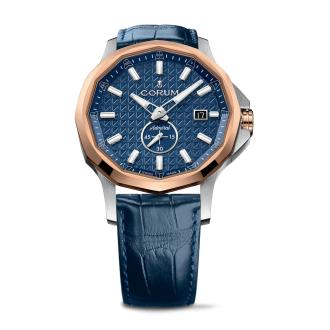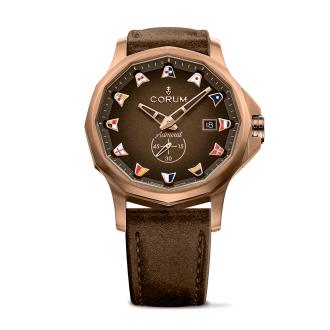The ocean is a vast playground for watchmakers. From dive watches engineered for the deep to the beauties that won’t stray further than the boardwalk and the sports models designed to embark with a racing yacht’s crew, the sea has been a favourite source of inspiration for more than a century. Omega, Panerai, Breguet, Rolex, Blancpain, Ulysse Nardin, RALF Tech, TAG Heuer, Breitling, ArtyA, Bell & Ross and countless others have dipped their toes. Corum, too.
1960, maiden voyage
With its philosophy to always do different, the aesthetic originally chosen by the Chaux-de-Fonds brand was a million (nautical) miles from the sportiness expected of a nautical watch. The very first iteration, in 1960, of the Admiral’s Cup was an elegant dress watch designed to be worn at regattas by spectators cheering from the shoreline and certainly not by the competitors themselves. Some twenty years later, the design was dropped.
1983, renaissance
The Admiral’s Cup as we know it today began its odyssey in earnest in 1983. Out went the square case in gold. In came the twelve-facetted bezel (not unlike Omega’s pie-pan Constellation, introduced in 1952) and a similarly dodecagonal case.

As for the dial, Corum came up with a stroke of genius and replaced the 12 hour markers with 12 nautical pennants from the International Code of Signals. These colourful flags gave the Admiral’s Cup an identity so closely associated with the watch, and with Corum, that no other brand has deployed these symbols. The only vaguely comparable reference, rarely spotted by collectors, is the counterweight on the seconds hand of the latest Breguet Marine, shaped like the flag for the letter B in the nautical alphabet.
A distinguished career
To say that the Admiral’s Cup has undergone numerous evolutions throughout its 40 years would be an understatement, but it has remained a stalwart of Corum’s catalogue through thick and thin. Indeed, this longevity has become one of its defining features, alongside the colourful flags on its dial. Apart from a couple of unlikely and unwearable renditions (mainly quartz, skeleton or jewellery versions), the 12 nautical pennants have always featured as a visual hallmark, even when reduced to their simplest form (a mere outline) or tucked away on the flange. What greater proof that Corum has always followed its own stylistic inspirations. Its history (Coin, Rolls Royce, Feather, etc.) stands as a reminder that this is one of the most inventive watch brands ever.
Corum has explored multiple facets of the Admiral’s Cup over the past four decades, always with a nautical streak. Names have varied too, from the Admiral’s Cup to the AC, the Admiral or, a shoutout to its diameter, the AC40 including a Competition version. There have been other generous (to say the least) case sizes, stretching as far as 48mm: like most other supersized watches, it sank without a trace.

Changing faces
Explorations of colourways, complications and materials have proven considerably more successful. As a regatta watch, the chronograph was an obvious choice. As a sports watch, the steel case/rubber strap combo was a no-brainer.
Rarer and more out of the ordinary, a version with a wood dial cleverly hints at the teak deck of classic sailing boats while the addition of a titanium case underscores the watch’s sporting credentials. Certain AC-One boast an aged bronze case, of the kind seen at Bell & Ross or Ferdinand Berthoud. As mentioned, the Admiral’s Cup has embraced complications, not least a rarely seen 47mm Seafender with a tourbillon and second time zone, which was also proposed as a jewellery version with diamonds on the case and bezel. Similarly, the Legend model came with a superb mother-of-pearl marquetry dial - in keeping with the watch’s maritime aspirations.
In 1992 Corum introduced the Admiral's Cup Tides. Equipped with an exclusive movement, the CORUM CO 277, it indicates vital information for sailors, such as tide times, the strength of the current, and the height and strength of the tide. The next major refresh took place in 2006, a year after Antonio Calce (now CEO of Greubel Forsey) took the helm. With recent releases that include avant-garde models in luminescent carbon, the Admiral’s Cup clearly has the wind in its sails.








